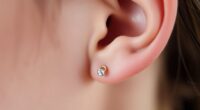Transdermal implants and magnetic piercings are bold body modifications that let you express yourself in unique ways. Transdermal implants are devices embedded beneath your skin, while magnetic piercings use magnets instead of traditional holes. Both require careful planning, professional guidance, and diligent aftercare to prevent infections and complications. Understanding safety measures, cultural considerations, and potential risks can help you make informed choices. If you’d like to explore more about these innovative modifications, you’re in the right place.
Key Takeaways
- Transdermal implants are embedded devices beneath the skin, offering unique self-expression options beyond traditional piercings.
- Magnetic piercings use magnets instead of skin perforation, providing a less invasive alternative with distinct aesthetic appeal.
- Both modifications require careful research, professional guidance, and strict sterilization to ensure safety and proper healing.
- Risks include infection, skin irritation, allergic reactions, and trauma; proper aftercare minimizes complications.
- Cultural significance and ethical considerations enhance understanding and respectful adoption of these body modification techniques.

Transdermal implants and magnetic piercings are innovative body modifications that push the boundaries of traditional piercing. These procedures offer a unique way to express yourself, but they also require careful consideration of safety precautions. Unlike standard piercings, transdermal implants involve embedding a device beneath the skin, making infection control and proper aftercare critical. Before getting one, you should thoroughly research experienced practitioners who follow strict sterilization protocols. It’s essential to understand the healing process, which can take several months, and to follow all aftercare instructions diligently to prevent complications. Magnetic piercings, on the other hand, use magnets instead of holes through the skin, offering a less invasive way to adorn your body. Still, even these can cause skin irritation or allergic reactions if not placed correctly or if you have sensitive skin. Always consult a professional who understands how to minimize risks, and avoid handling the magnets roughly during healing to reduce trauma and infection. Additionally, understanding infection control is crucial to ensure safe healing and prevent complications. Recognizing the cultural importance behind body modifications helps you appreciate their deeper value beyond aesthetics. It also reminds you to approach these practices with respect, especially if you’re adopting symbols or styles rooted in specific traditions.
Frequently Asked Questions
How Long Do Transdermal Implants Typically Last Before Replacements Are Needed?
Transdermal implants typically last between 5 to 10 years, depending on factors like material durability and how well you care for them. High-quality materials, such as surgical-grade titanium or biocompatible alloys, tend to have longer implant longevity. Regular check-ups with your piercer or doctor help monitor their condition, ensuring you know when replacements are needed to prevent complications. Proper maintenance can extend the lifespan of your implant considerably.
Are Magnetic Piercings Safe for Individuals With Pacemakers or Other Medical Devices?
Magnetic piercings are like a wild river—dangerous if you’re unprepared. If you have a pacemaker or other medical devices, they’re generally unsafe because of potential medical device interactions and magnetic field safety concerns. The magnetic fields can interfere with device functioning, risking serious health issues. Always consult your healthcare provider before getting any magnetic piercings, especially if you have medical implants, to safeguard your safety.
What Are the Risks of Allergic Reactions to Implant or Piercing Materials?
You might experience allergic reactions if you’re sensitive to certain materials used in implants or piercings. Allergic sensitivities can cause redness, swelling, itching, or even infection. To minimize risks, guarantee material compatibility by choosing hypoallergenic options like surgical steel, titanium, or biocompatible plastics. Always consult with a professional before getting pierced or implanted, especially if you have a history of allergies, to reduce potential adverse reactions.
How Should Transdermal Implants and Magnetic Piercings Be Cared for During Healing?
Imagine getting a magnetic piercing and wondering how to care for it during healing. You should follow strict cleaning routines, gently washing the area with saline solution twice daily, and avoid touching or twisting the implant. Keep the area dry and protected from irritation. Typically, the healing timeline takes several weeks to months, so stay consistent with your care to prevent infections and guarantee proper healing.
Can Magnetic Piercings Interfere With Electronic Devices or Credit Cards?
Magnetic piercings can cause electromagnetic interference, potentially affecting electronic devices or credit cards nearby. The magnetic field effects from these piercings may disrupt the operation of sensitive electronics, especially if placed close to devices like smartphones or card readers. To avoid issues, keep electronic devices and magnetic credit cards at a safe distance from your magnetic piercing, especially during the healing period when the magnetic field effects are strongest.
Conclusion
Now that you know the ins and outs of transdermal implants and magnetic piercings, you might be wondering if they’re right for you. These body modifications can be bold and unique, but they also come with risks and maintenance needs. Are you ready to embrace this level of self-expression and take the necessary precautions? Ultimately, it’s all about making an informed decision that aligns with your style and comfort. Are you prepared to make that leap?
Piecing together a life one day at a time, that’s me. I’m Rusty, and I love being editor-in-chief of creative piercing. It’s my passion to help others see their vision and bring it to life. When I’m not working or taking care of my family, you can find me reading a good book or eating pie (of course!).

















